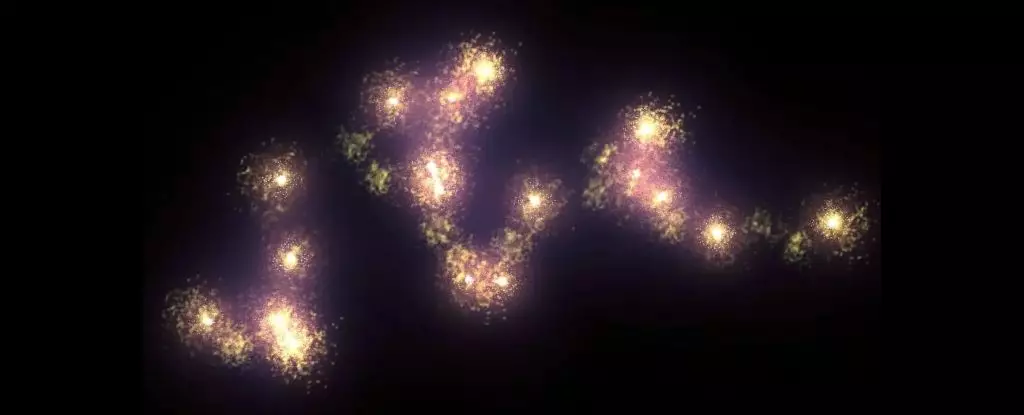In the ever-unfolding narrative of our cosmos, a groundbreaking study threatens to reshape our understanding of the Universe’s largest structures. The Hercules-Corona Borealis Great Wall, initially estimated at an already staggering 10 billion light-years, could actually stretch to a cosmic-length of 15 billion light-years. This revelation prompts profound questions not only about the Great Wall itself but also about the fundamental principles that govern the cosmic landscape. Such findings compel us to confront the limits of our knowledge and fundamentally challenge long-accepted concepts within astrophysics.
Gamma-Ray Bursts: Cosmic Signposts
Gamma-ray bursts (GRBs)—the Universe’s most energetic explosions—play a key role in this investigation. These eruptions, resulting from cataclysmic events like the merger of neutron stars or the death throes of massive stars giving rise to black holes, are crucial markers within the fabric of the Universe. Their brightness allows astronomers to observe these events across vast expanses, enabling the mapping of galaxies and clusters. In 2014, a team led by scientists István Horváth, Jon Hakkila, and Zsolt Bagoly identified the initial concentration of these explosions, which highlighted a significant clustering—thus unveiling the existence of the Great Wall. Since then, further scrutiny has led to the examination of 542 GRBs with known redshifts, yielding revelations that broaden our perspective on cosmic structures.
Redshift and Cosmic Metrics
Redshift, the phenomenon whereby light from celestial objects shifts toward longer wavelengths as the Universe expands, serves as a crucial metric in astronomical measurements. The detailed analysis of this redshift in the recent study clarified that the Hercules-Corona Borealis Great Wall possibly spans a staggering distance from 0.33 to 2.43 in terms of redshift. This recalibration places the Great Wall’s size within an awe-inspiring range of around 15 billion light-years. To put this into perspective, while the observable Universe measures about 93 billion light-years across, encountering structures of such magnitude introduces complexity that fundamentally alters our comprehension of cosmic homogeneity.
The Challenge to Cosmological Principles
The implications of the Great Wall’s expanded size are profound. The cosmological principle, one of the bedrocks of modern astrophysics, posits that on a sufficiently grand scale, the Universe should exhibit homogeneity and isotropy—essentially meaning it looks the same regardless of the direction in which we observe. However, structures exceeding a mere 1.2 billion light-years are categorized as significant outliers, suggesting non-uniformity. With the new findings presenting the Great Wall as one such outlier, alongside other notable structures such as the Clowes-Campusano LQG and the Giant Arc, it becomes increasingly evident that our Universe may be more intricately woven than previously thought.
From Speculation to Reality
The debate surrounding the existence of the Great Wall has metamorphosed from speculation into stark reality. Allegations of statistical fluctuation or sampling bias in the earlier identification of this astronomical feature seem to dissipate in light of the latest data. Instead of an isolated anomaly, evidence now suggests that we are dealing with a complex and substantial feature, reaffirming the importance of thorough observational statistics in the field of cosmology. What the full implications of such structures entail for our comprehension of cosmic evolution remains largely unexplored. However, this ongoing research undeniably exposes gaps in our understanding, ultimately grounding the discovery in empirical evidence rather than mere conjecture.
What Lies Beyond?
Despite the monumental discoveries that have been made, the quest for knowledge about the Universe is far from complete. These findings evoke a sense of humbleness when faced with the vastness of what remains unknown. Each new discovery serves as a reminder that while we inch closer to deciphering the cosmic order, many enigmas lie ahead. Where will our investigations lead us next? The answers to such questions are uncertain, but they promise to unveil new dimensions of our existence that we are yet to comprehend fully.
In an age where technological advancements propel us to observe deeper into the fabric of space-time, the potential for discoveries that could redefine our understanding is monumental. The Hercules-Corona Borealis Great Wall stands as a testament to humanity’s enduring curiosity and the unyielding drive to explore the cosmos. The revelations brought forth through rigorous academic pursuit not only invite us to challenge and reshape our cosmic narrative but also inspire awe at the mysteries the Universe holds.


Leave a Reply